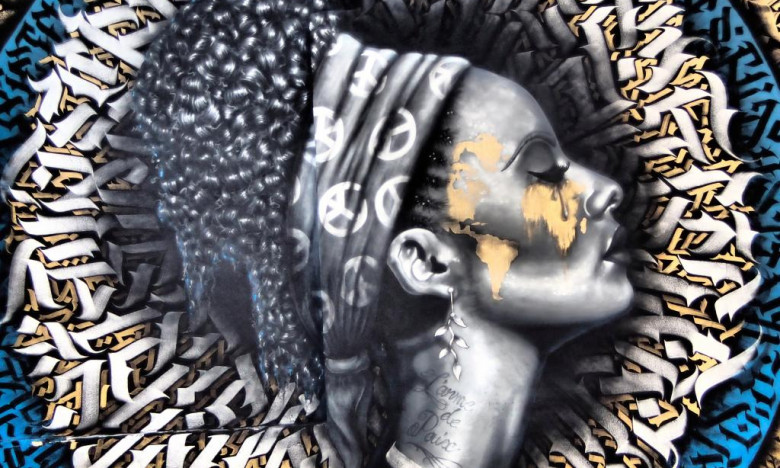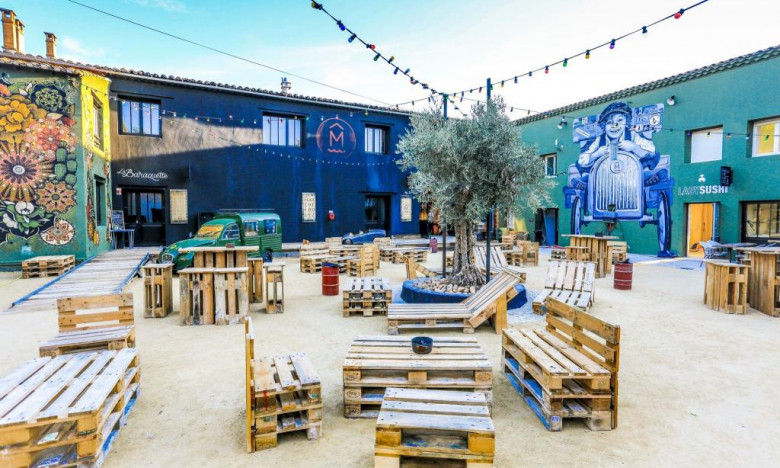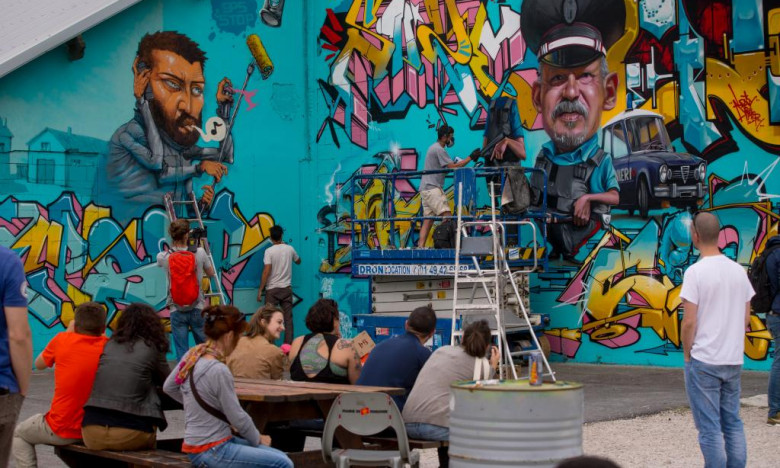There was a time in France when graffiti was a bad word. It certainly wasn't synonymous with art. But times have changed. Since the 1990s, a slow but steady reckoning has elevated appreciation of urban art, loosely defined as creative works that relate to cities and are made by people who live in them, including graffiti and street art using stencils, posters, stickers, murals and more. In fact, these days urban art has been lauded by some as a very significant movement in recent art history.
Increasingly, in France and around the world, street artists who once dodged municipal authorities are now commissioned to decorate their towns, sometimes on a monumental scale. Annual street art festivals attract thousands. Cities are collaborating with local street art associations to make wall space freely available for outpourings of creativity. And special street art tours are helping educate about what lies behind the dazzling, kaleidoscopic washes of color.
Many members of a French association of regional capitals and smaller cities, called Top French Cities, are no stranger to this cultural awakening. Here are eight in the southern reaches of the country that have served as canvases for talented graffeurs.
Aix-en-Provence: Visitors to Aix walk in the footsteps of its famous 19th-century son, artist Paul Cézanne. But guided street art tours ensure that they also stroll in the shadow of its newfound modern children's fantastic urban art. To help this happen, KA Divers promotes street art through programs and workshops at festivals like Zik Zac and Le Street Nécessaire. Learn more about Aix-en-Provence.
Annecy: Graced with historic monuments overlooking age-old canals, Annecy is called Venice of the Alps. Nowadays its history and byways are even more alluring during Annecy Paysages, a summer celebration of artistic creation and landscape transfiguration in public urban spaces. It's a festival built around itineraries through town that take in art installations both during the day and at night. Learn more about Annecy. Learn more about Annecy.
Bordeaux: A marvel of 18th-century urban planning and neoclassical architecture, Bordeaux is adding new colorful layers to its city history. This is on especially bold display during Shake Well, its three-day, international graffiti festival. Managed by the Alchimist association, a group of urban artists, it has live street art showcases, graffiti workshops for all ages, an artisans village and more. Learn more about Bordeaux.
Grenoble: Encircled by dramatic natural scenery, Grenoblois have always been alert to their surroundings. Is it any wonder then that they host Street Art Fest, Europe's leading festival for street art, revealed in its entirety through all its disciplines? At other times of year, a Street Art Discovery Circuit guides visitors to monumental works, green murals and other abundant urban art displays. Learn more about Grenoble.
Marseille: Startling contemporary urban architecture has given Marseille a new identity. So has the abundant urban art of one of the world's most heavily tagged cities. The Street Art Festival du Cours Julien pays special tribute to the city's street art epicenter: Cours Julien. Two-hour guided visits take it all in there or in the equally polychromatic Panier neighborhood. Learn more about Marseille.
Montpellier: Montpellier appreciates its heritage, from its narrow medieval alleys to its wide modern boulevards. This multi-layered recognition extends to street art, particularly in the Verdanson area, cradle of the urban art scene. Here, on a guided walking tour, several generations of tags can be identified. For more in-depth learning, Montpellier Loves Street Art publishes free online guides about selected artists. Learn more about Montpellier.
Nîmes: In this city of audacious invention, street art has found its place alongside newly dedicated building projects as bold as those of the city's ancient Romans (whose structures remain to this day), high-profile festivals and other quality fabric-of-life undertakings (pun intended: Nîmes is where denim jeans originated). During L'Expo de Ouf!, guided walking tours take in new and old murals. Learn more about Nîmes.
Toulouse: No need for rose-tinted lenses to admire the pink-brick beauty of old Toulouse. Or, these days, the Arnaud-Bernard quarter, where, back in the 1990s, the now-famous Truskool collective were street art pioneers. Their works are singled out during tourist office-run graffiti tours and festivals like Rose Béton or Mister Freeze, France's largest expo of urban contemporary art and graffiti. Learn more about Toulouse.
About Top French Cities – www.francepresskit.com
Top French Cities is an association of 29 cities, from regional capitals like Bordeaux to important towns like Avignon and Versailles. They are perfect for young travelers, families and anyone else looking for fun and authentic French experiences that will fit their budget. Most of these cities are university towns with a youthful atmosphere, but all of them reflect the heritage and distinctive flavors of the regions to which they belong. Many are forward-looking too, with historic buildings repurposed to house contemporary art and activity centers like Les Docks in Marseille. Many have created or integrated new, modern museums to contrast with their classical, architectural heritage, like in Nimes, where the cutting-edge Museum of Roman Civilization (Musée de la Romanité) is located across from the historic Roman amphitheater, or in Nantes, where whimsical mechanical creatures are being created, or in the UNESCO World Heritage Site concrete city of Le Havre.




